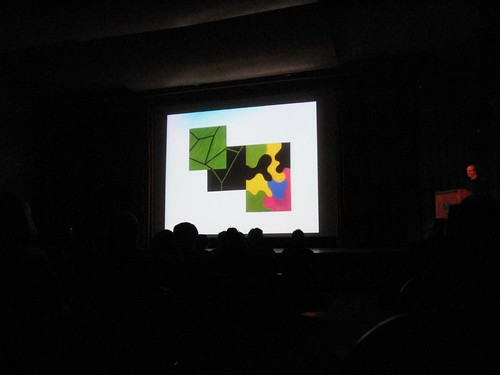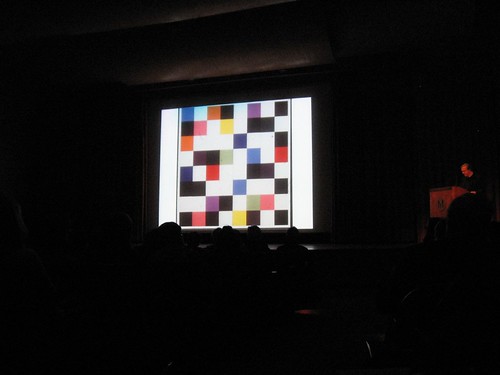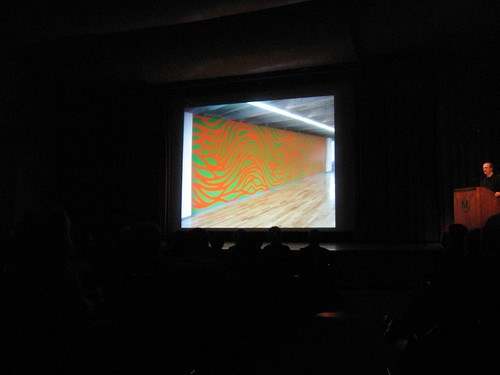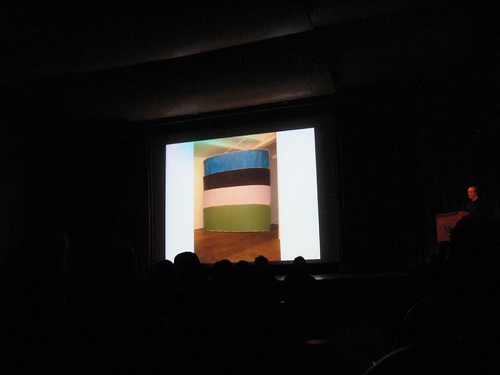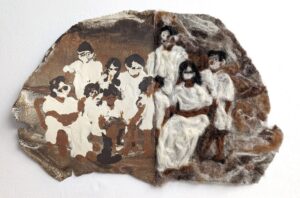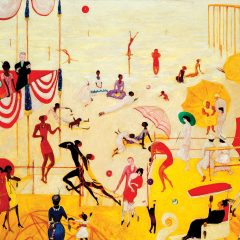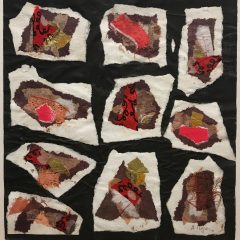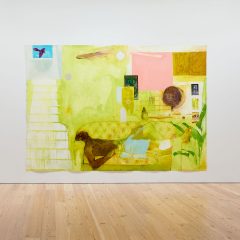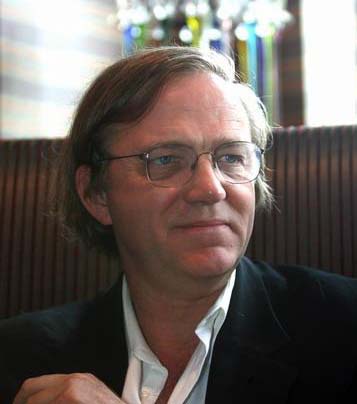
We were interested to hear Yale Dean and curator Robert Storr on abstract art, part of a series of 3 lectures at the Met. The series seems to be about contextualizing up-and-coming artists in the canon. Here’s who was under discussion last Saturday: (in the canon already)– Ellsworth Kelly, Sol LeWitt, Robert Ryman, Jasper Johns, and Gerhard Richter—and (not there yet but Storr wants to put them in) — Odili Donald Odita, Tom Nozkowski, Mary Heilmann, El Anatsui and Ron Gorchov.
Many of the examples Storr used of great artists not in the canon were artists he’s worked with, written about and clearly has an affinity for. So in that respect the lecture was a “my favorite artists” lecture and a defense of his curatorial ouervre.
Saturday’s lecture began with a acknowledgement of Andrew Wyeth, who passed away Friday. Storr said Wyeth denied modernity and painted American nostalgia but Hopper, another brand of realist, painted modernity in America. From there Storr began questioning the terms that we use to describe paintings. He launched into how there are many abstractions just like there are many realisms, and that realism is not exactly real and that abstraction can be real.
If you write art history with crude patterns, led by heroes, you lose a lot of the complexity of what is really happening, Storr said. It’s not who leads but who else is present. And it’s misleading to focus on the masters or the originators of new ideas because they’re not always the ones who move the entire story forward. Mastery and origination of new ideas don’t go hand in hand. The follower masters the new idea most often. So we should be avoiding hero narratives.
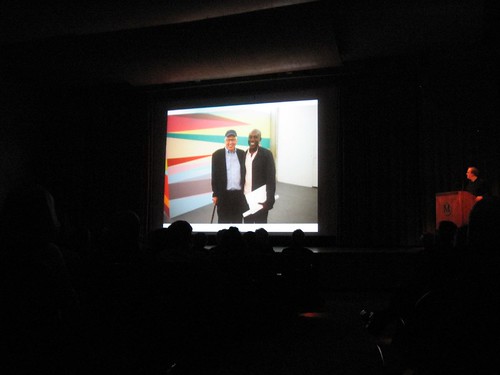
Ellsworth Kelly and Odili Donald Odita at the 2007 Venice Biennale, standing in front of Odita’s wall painting.
Here is who he covered in his talk, including some new names, some overlooked names and some widely accepted masters. (He mentioned in addition to those we list below, Allan McCollum, Brice Marden, Robert Mangold and Marine Hugonnier. And in the two-question Q&A he acknowledged Sam Gilliam‘s draped paintings as being important and he brought up Elizabeth Murray but said he decided not to include her in this lecture).

Jasper Johns, Painting Bitten by a Man
Jasper Johns — (early 50s) The beginning of post modernism. Johns’ work is not abstract painting. It’s object as painting; it’s a critique of painting; it’s talking to painting-centered painting (like abstract expressionism).
Louise Lawler — We’re not sure why he included it but a photo of Lawler’s showing a Frank Stella painting reflected in the floor of Castelli Gallery provoked this from Storr: “For my money, it’s one of the most beautiful renditions of Stella, which is not to take him down,” he said. We’re keeping Lawler in this list to keep up the count of women who he included, since the group is rather male-centric. Also in relation to this photo he mentioned that Walter Benjamin spoke a lot about aura, which is something unique in time and space and becomes a dialogue between the object and the viewer.
Sigmar Polke — The toxic lacquers piece at the Biennale 2007 talks back to Johns’ canvas on canvas. Polke’s surface is a scrim through which the stretchers show. It’s painting talking to painting-centered painting, too. Here’s a picture.
Philip Taaffe — decorative motif on a Kelly-like background. The decorative motif is like one in a de Groot painting. “Decorative is not bad unless you believe art is about denial of pleasure as some poor souls believe.”
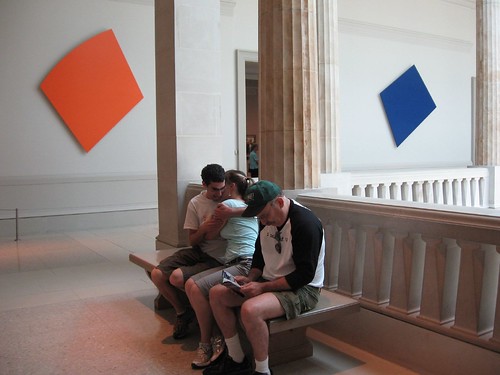
Ellsworth Kelly at the Chicago Art Institute, with Ben, Minna and Murray on the bench.
Ellsworth Kelly –He used Kelly as a sort of touchstone for the talk for his paintings of skewed squares and their conversation with the rectangular environment in which they hang.
Robert Ryman — He moves abstraction to realism–he’s not abstract. The reality of his materials are the substance of his paintings. “I did an exhibition with Ryman and the person doing the color corrections for the catalog had a nervous breakdown…Who has kept abstraction from exhausting itself? The answer is Ryman and Richter.” He didn’t compare him to Jasper Johns, but the relationship seems clear to us. They’re both materials guys.
Gerhard Richter–Richter too is about materials. His paintings are made on surfaces with nontraditional tools with a squeegee spreading the paint. In part his work is accidental and in part it is controlled. He chooses the process and then selects from the results, which is different than making a painting. He’s influenced by John Cage. And he’s not about the psyche.
Richard Tuttle–Vis a vis his small sculptural pieces and Frank Stella’s huge sculptural pieces, “Tuttle is the chamber music response to Stella’s orchestral version.”
Sol LeWitt — There’s a mural at Mass MoCA. It will be there 25 years. The viewer moves through space and the painting moves through space as the background falls away. With LeWitt, you can always make a fresh one. People have often thought of Lewitt as cerebral and cold, but he was anything but, Storr said. LeWitt seems pretty cerebral and cold to us, however. But we love his M.O.–he’s a collaborator.
Odili Donald Odita –Like LeWitt, Odita’s work is delegated. “We overvalue the authorial hand.” Though he didn’t say it, Odita’s work also references Kelly’s non-squares and Kasimir Malevich.
Mary Heilmann–She’s in her 70s; she’s emerging now but got piled under. She’s moving away from fetishization of the beautiful surface. Kelly was interested in her work.
Ron Gorchov–also old, discovered late. Gorchov is like Tom Nozkowski. He came out of Surrealism and went abstract but kept it fresh. His curved canvas is different than the taut canvas. He creates a new arch in the room.
El Anatsui–No paint–he’s using foil from liquor bottles, connected with copper rings, to create a giant chain mail cloth that will look different every time it’s shown. But he is using painting conventions. He will have a major retrospective soon at the Museum Art and Design.
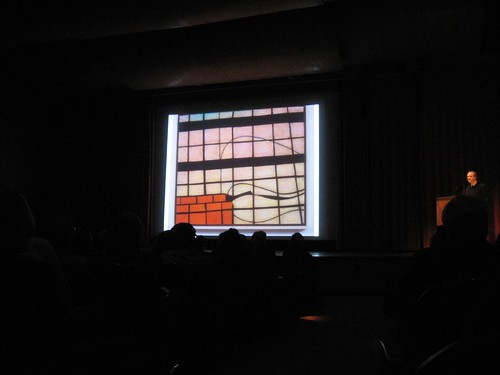
Tom Nozkowski painting on the screen and Storr at the podium
Tom Nozkowski–Operating below the radar all these years, he is about to have his first retrospective at the National Gallery of Canada. A body of work with integrity and counters the story of instant fame.
Finally, he said abstraction is as real as realism.


